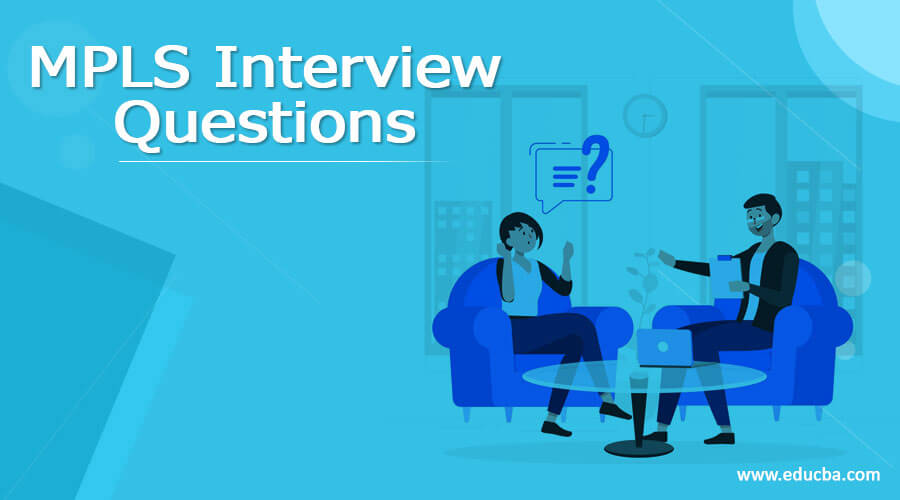Updated July 28, 2023

Top 25 MPLS Interview Questions
List of top 25 MPLS Interview Questions are:
1. What Is MPLS? What Are the Advantages of MPLS?
Multiprotocol label switching provides a way to process packets based on their labels. It’s a data forwarding service that uses labels instead of routing table lookups to enable high-end network communications from one network node to the next. The need to look up the routing table for each packet slows communication, whereas MPLS utilizes the LFIB/forwarding table to transfer labels from one node to the other.
The following are the key advantages of using MPLS:
- Multiple degrees of QoS are supported to regulate latency, jitter, and packet loss for various types of traffic (voice, video, email, bulk file transfers, etc.)
- Convergence is quick thanks to label-based switching, which eliminates the need to seek for routing tables.
- IP VPNs are scalable.
- Using MPLS TE, network congestion is kept to a minimum.
- Reliable and safe
2. Which Protocol does MPLS Employ?
TDP or LDP are used by MPLS.
3. Which Layer does MPLS Work on?
It functions between layers 2 and 3.
4. Which Functions are done by MPLS?
- PUSH (Adding the label)
- SWAP (Changing the label)
- POP (Removing the label)
5. How do you Tell the Difference between a P and a PE Router?
Customer network routes are not available on the P router, but they are available on the PE router. Another reason is that whereas P routers do not require MP-iBGP, PE routers must.
6. Is it Possible to Set the PE Router to P Mode?
One must remove the BGP configurations from the PE router to make it a P, after which it will not participate in the customer network.
7. How many lDP Sessions will be Established if Two Routers have Four Equal-Cost Links?
One session
8. What Exactly is Penultimate Hop Popping, and Why Is It so Important? Which Router Is Responsible for The PHP Function?
The Penultimate Hop Popping function is used by the second last router to remove the topmost label.
9. What is TTL Propagation?
It is process of copying the TTL value from IP header to MPLS header.
10. What Are the Many Types of Labels?
Explicit Null, Implicit Null, Aggregate Label.
11. What is the difference between Explicit Null and Implicit Null?
Explicit Null i.e. Label 0 is used for QOS and disables PHP behaviour.
Implicit Null i.e. Label 3 is used to indicate other router to remove label before sending the packets.
12. How can I make a customer path that is unique?
By addition a route distinguisher.
13. What exactly is the distinction between RD and RT?
RD is not a part of a larger community, although RT is.
14. Is It Possible to Allocate the Same Rd to Two Customers?
RD is unique and specific to the router.
15. What are BGP Path Attributes for Controlling Incoming And Outgoing Traffic?
BGP provides a number of path attributes that can be used to influence traffic flow. We alter incoming traffic using AS-Path prepending and MED in the most frequent technique (multi-exit discriminator). Weight and local preference are the best ways to affect outbound traffic.
16. Is Summarization Recommended in MPLS?
No
17. How Do You Tell the Difference Between Vpnv4 And Ipv4 Address Families?
VRF communication, which is much bigger (96 bits) than typical IPv4 packets, is transported by address-family VPNv4, whereas ordinary 32-bit IPv4 packets are transported by address-family IPv4. When deploying L3VPN, VPNv4 peering between PEs is required to route VRF routes (tagged with RD, RT) to the appropriate destination PE router.
18. How can MPLS Labels be Filtered?
By Using Access Control Lists (ACLs).
19. In Cisco Routers, What is the Default Range of MPLS Labels? What’s the Best Way to Broaden That Range?
The default range is 16–100,000.
20. Can I use MPLS Without a Route Reflector?
Yes, full mesh BGP development is required.
21. What Exactly is MP-iBGP? is it Possible to Utilize Regular BGP Instead of MP-iBGP?
No, MP-iBGP is utilized because it supports multiple protocols that standard BGP does not.
22. What is CEF, and Can MPLS be Made to Work Without it?
In Cisco routers, CEF is required for MPLS.
23. Is LDP dependent on OSPF, IS-IS, or BGP?
IP Reachability necessitates the use of IGP.
24. What Is the Transportation Address?
The route id is the transportation address.
25. Could yoU Please Explain What SYSVOL is?
The server’s copy of the domain’s public files is kept in the SysVOL folder. The contents of the sysvol directories, such as users, group policies, and so on, are duplicated to all domain controllers in the domain.
Conclusion
That concludes our list of the most popular MPLS interview questions and answers. Reading this list will undoubtedly help you in tightening up your MPLS interview preparation. I hope you will find this article helpful.
Recommended Articles
This is a guide to MPLS Interview Questions. Here we also discuss the MPLS interview questions along with answers and detailed explanations. You may also have a look at the following articles to learn more –
